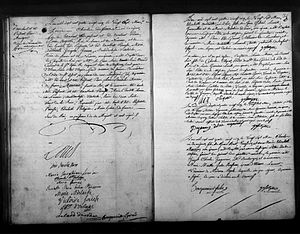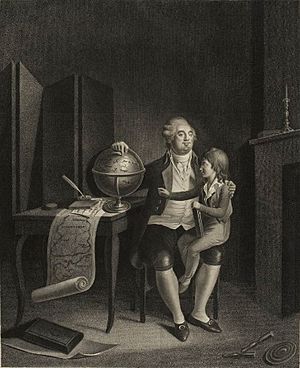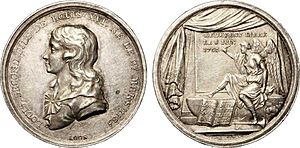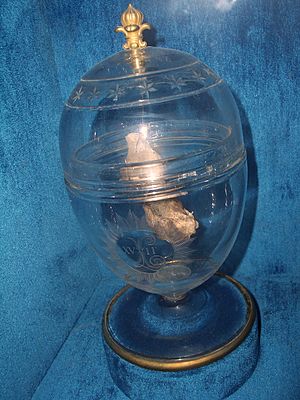Louis XVII facts for kids
Quick facts for kids Louis XVII |
|||||
|---|---|---|---|---|---|
| Duke of Normandy/Dauphin of France | |||||

Portrait by Alexander Kucharsky, 1792
|
|||||
| King of France (claimant) | |||||
| Tenure | 21 January 1793 – 8 June 1795 | ||||
| Predecessor | Louis XVI | ||||
| Successor | Louis XVIII | ||||
| Born | 27 March 1785 Palace of Versailles, Kingdom of France |
||||
| Died | 8 June 1795 (aged 10) Paris Temple, France |
||||
| Burial | 10 June 1795 Cimetière Sainte-Marguerite, Paris, France |
||||
|
|||||
| House | Bourbon | ||||
| Father | Louis XVI of France | ||||
| Mother | Marie Antoinette | ||||
| Religion | Catholicism | ||||
| Signature | |||||
Louis XVII (born Louis Charles, Duke of Normandy; 27 March 1785 – 8 June 1795) was a young prince of France. He was the younger son of King Louis XVI and Queen Marie Antoinette. His older brother, Louis Joseph, died in June 1789. This was just before the start of the French Revolution.
When his brother died, Louis Charles became the new Dauphin. This title meant he was the next in line to the throne. In 1791, a new constitution changed the title to Prince Royal. His father, King Louis XVI, was executed on 21 January 1793. At that moment, many royalists saw Louis Charles as the new king, Louis XVII.
However, France was no longer a kingdom; it was a republic. Louis Charles was held prisoner and died in June 1795. He never actually ruled as king. Later, in 1814, his uncle became King Louis XVIII.
Contents
Early Life of Louis XVII
Louis-Charles was born at the grand Palace of Versailles. He was the second son and third child of King Louis XVI and Queen Marie Antoinette. He was given the title of Duke of Normandy at birth.
Like other royal children, Louis-Charles had many people caring for him. His mother, the Queen, chose governesses to look after her children. When the French Revolution began, the first governess left France. She was replaced by the marquise Louise Élisabeth de Tourzel.
On 6 October 1789, a large group of people from Paris forced the royal family to leave Versailles. They moved to the Tuileries Palace in Paris. For the next three years, they lived there as prisoners. Guards watched them closely every day.
The family lived a quiet life. Marie Antoinette spent most of her time with her two children. On 21 June 1791, the family tried to escape. This event is known as the Flight to Varennes. But their attempt failed, and they were brought back to Paris.
On 10 August 1792, an armed crowd attacked the Tuileries Palace. The royal family had to seek safety with the Legislative Assembly.
Life in Prison
On 13 August 1792, the royal family was imprisoned in the Temple tower. At first, their prison conditions were not too harsh. But they were now called "Capets" by the new Republic. On 11 December, King Louis XVI was separated from his family.
Becoming a Prince and King
When Louis-Charles was born, he was called a Fils de France. He was given the title of Duke of Normandy. On 4 June 1789, his older brother, Louis Joseph, died. Four-year-old Louis-Charles then became the Dauphin of France. This meant he was the heir to the throne.
In September 1791, France became a constitutional monarchy. Under the new rules, the heir to the throne was called the Prince Royal. Louis-Charles held this title until the monarchy was ended on 21 September 1792.
When his father died on 21 January 1793, royalists and other countries saw Louis-Charles as the new King Louis XVII. His uncle, the Count of Provence, who was living in exile, declared himself the Regent. This meant he would rule for the young, imprisoned king.
Life with Antoine Simon
After Louis XVI was executed, people tried to help the royal prisoners escape. On 3 July, Louis-Charles was separated from his mother. He was placed in the care of Antoine Simon, a shoemaker. Simon was named his guardian by the government.
Illness and Neglect
On 19 January 1794, the Simons left the Temple. They said Louis-Charles was in good health. However, some stories from later historians say that Louis-Charles was then put in a dark room. It was said to be like a cage. Food was passed to him through bars. The room became very dirty.
A government official named Barras visited the prison in July 1794. He described the boy as suffering from extreme neglect. But he did not mention the room being walled up. The boy was then cleaned and given new clothes. His room was cleaned too.
He had new attendants, Jean Jacques Christophe Laurent and later Gomin. Louis-Charles was taken for walks on the tower roof. From late October, the boy stopped speaking. He remained silent.
The Death of Louis XVII
In May 1795, Louis-Charles became very ill. Doctors were called to examine him. Louis-Charles died on 8 June 1795. He was just 10 years old.
The next day, doctors performed an autopsy. They said the boy had died from a long-term infection called scrofula. This is a type of tuberculosis that affects the neck glands. The doctors also noted many scars on the boy's body. These scars showed that the child had been mistreated while in prison.
Louis-Charles was buried on 10 June in the Sainte Marguerite cemetery. No marker was placed on his grave.
The Heart of Louis-Charles
Following a royal tradition, Louis-Charles's heart was removed during the autopsy. Dr. Philippe-Jean Pelletan secretly took the heart. He kept it in distilled wine to preserve it.
Years later, Dr. Pelletan tried to give the heart to Louis-Charles's uncle, King Louis XVIII. But the king did not believe it was his nephew's heart. So, Dr. Pelletan gave it to the Archbishop of Paris.
Over the years, the heart was passed down through different people. In 1999, a small piece of the heart was taken for DNA testing.
In 2000, historians arranged for the DNA tests. Scientists compared the heart's DNA to a strand of hair from Louis-Charles's mother, Marie Antoinette. They also used samples from her relatives. The tests proved that the heart belonged to Louis-Charles.
Because of these results, the heart was formally buried. This special ceremony took place on 8 June 2004. It was held at the Basilica of Saint-Denis in Paris. This is where many French kings and queens are buried. A 12-year-old prince carried the heart. He placed it next to the tombs of Louis-Charles's parents, Louis XVI and Marie-Antoinette.
The Lost Dauphin Claimants
After Louis-Charles died, rumors spread that he had escaped. Many people believed that the body buried was not really his. This led to the legend of the "Lost Dauphin." When the French monarchy was restored in 1814, over a hundred people claimed to be the lost prince.
Famous Claimants
- Karl Wilhelm Naundorff: He was a German clockmaker. He claimed that the real dauphin was secretly swapped with another child in prison. Naundorff said he was that real dauphin. He even tried to get his royal rights back in court. However, DNA tests in 1993 proved that Naundorff was not Louis-Charles.
- Baron de Richemont: He claimed that a kind prison guard helped him escape in a basket.
- Eleazer Williams: He was a Native American missionary from Wisconsin. He claimed he was Louis-Charles. He said he had no memory of his escape or early life in France. He even claimed a French prince asked him to give up his rights to the throne.
These stories were very popular, especially after the 1830 Revolution. But most of these claims are now seen as false. The DNA evidence from Louis-Charles's heart helped to settle the question.
In Fiction
Louis XVII's story has inspired many books and movies:
- 1884 – Mark Twain, Adventures of Huckleberry Finn (a character pretends to be him)
- 1913 – Baroness Emmuska Orczy, Eldorado
- 1937 – Rafael Sabatini, The Lost King
- 2010 – Jennifer Donnelly, Revolution
Cinema
- 1937 – Le roi sans couronne
- 1938 – Marie Antoinette
- 1982 – The Scarlet Pimpernel
- 2006 – Marie Antoinette
Images for kids
-
Louis Charles by Élisabeth Vigée Le Brun
-
Queen Marie Antoinette with her children, 1787 at Versailles
See also
 In Spanish: Luis XVII de Francia para niños
In Spanish: Luis XVII de Francia para niños
- Alexei Nikolaevich, a Russian prince who was also imprisoned and killed.
- Edward V of England and Richard of Shrewsbury, Duke of York, two English princes who disappeared in the Tower of London.








